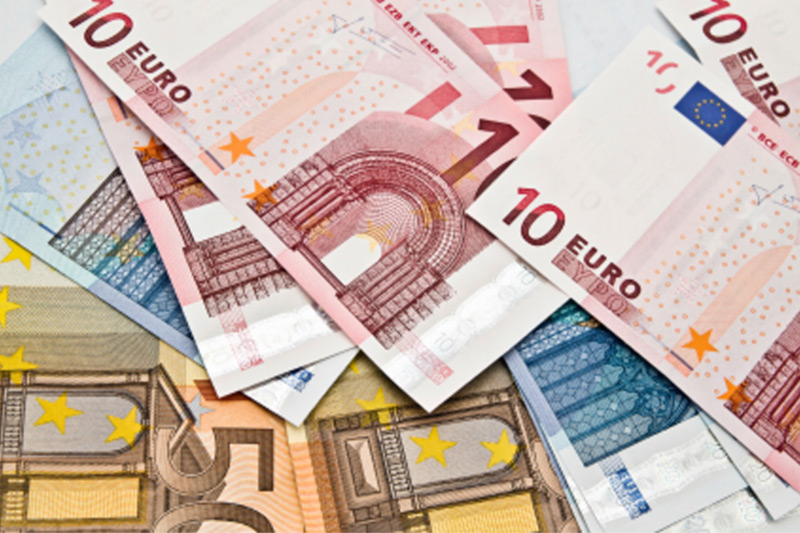Investing.com - The euro was down against almost all of its global counterparts on Wednesday, as concerns over Spain’s high borrowing costs weighed following a poorly received auction of government debt, while a flurry of weak data added to fears that the euro zone is entering a recession.
During European late morning trade, the euro was down against the U.S. dollar, with EUR/USD shedding 0.48% to hit 1.3170.
The cost of insuring Spain’s debt against default climbed earlier after the country auctioned EUR2.59 billon of government bonds, short of the maximum targeted amount of EUR3.5 billion.
On Tuesday, Spain’s government announced that the country’s public debt will rise to a record 79.8% of gross domestic product this year.
Earlier Wednesday, data confirmed that the euro zone service sector contracted for the sixth time in seven months in March, increasing the likelihood that the economy has entered a technical recession.
The final euro zone services purchasing managers’ index was revised up to 49.2 in March, from a preliminary estimate of 48.7, but remained below the 50 level that separates contraction from expansion.
A separate report showed that euro zone retail sales fell by 0.1% in February, against expectations for a 0.1% increase and were 2.1% lower year-on-year.
Meanwhile, official data showed that German factory orders rose 0.3% in February, below expectations for a 1.2% increase, renewing concerns over the economic outlook for the bloc’s largest economy.
The euro posted steep losses against the safe haven yen, with EUR/JPY tumbling 1.23% to hit 108.21.
The single currency was also lower against sterling, with EUR/GBP sliding 0.23% to hit 0.8296.
The pound was boosted by a report showing that the U.K. service sector expanded more-than-forecast in March, adding to hopes that the economic recovery is gaining traction.
The U.K. service PMI rose to 55.3 last month, its highest level since January and up from a reading of 53.8 in February. Economists had forecast a decline to 53.5 last month.
The euro was little changed against the Swiss franc, with EUR/CHF dipping 0.01% to hit 1.2038.
The shared currency was lower against the Canadian dollar but posted modest gains against the weaker Australian and New Zealand dollars, with EUR/CAD losing 0.18% to hit 1.3091, EUR/AUD adding 0.18% to hit 1.2831 and EUR/NZD rising 0.11% to hit 1.6176.
Sentiment on the Australian dollar was hit after official data showed earlier that the country posted a trade deficit of AUD0.48 billion in February, disappointing expectations for a surplus of AUD1.12 billion and fuelling fears over an economic slowdown.
Later in the day, the European Central Bank was to announce its benchmark interest rate.
Meanwhile, the U.S. was to publish a report non-farm employment change, as well as data from the Institute of Supply Management on service sector growth. In addition, U.S. Treasury Secretary Timothy Geithner was due to speak.
During European late morning trade, the euro was down against the U.S. dollar, with EUR/USD shedding 0.48% to hit 1.3170.
The cost of insuring Spain’s debt against default climbed earlier after the country auctioned EUR2.59 billon of government bonds, short of the maximum targeted amount of EUR3.5 billion.
On Tuesday, Spain’s government announced that the country’s public debt will rise to a record 79.8% of gross domestic product this year.
Earlier Wednesday, data confirmed that the euro zone service sector contracted for the sixth time in seven months in March, increasing the likelihood that the economy has entered a technical recession.
The final euro zone services purchasing managers’ index was revised up to 49.2 in March, from a preliminary estimate of 48.7, but remained below the 50 level that separates contraction from expansion.
A separate report showed that euro zone retail sales fell by 0.1% in February, against expectations for a 0.1% increase and were 2.1% lower year-on-year.
Meanwhile, official data showed that German factory orders rose 0.3% in February, below expectations for a 1.2% increase, renewing concerns over the economic outlook for the bloc’s largest economy.
The euro posted steep losses against the safe haven yen, with EUR/JPY tumbling 1.23% to hit 108.21.
The single currency was also lower against sterling, with EUR/GBP sliding 0.23% to hit 0.8296.
The pound was boosted by a report showing that the U.K. service sector expanded more-than-forecast in March, adding to hopes that the economic recovery is gaining traction.
The U.K. service PMI rose to 55.3 last month, its highest level since January and up from a reading of 53.8 in February. Economists had forecast a decline to 53.5 last month.
The euro was little changed against the Swiss franc, with EUR/CHF dipping 0.01% to hit 1.2038.
The shared currency was lower against the Canadian dollar but posted modest gains against the weaker Australian and New Zealand dollars, with EUR/CAD losing 0.18% to hit 1.3091, EUR/AUD adding 0.18% to hit 1.2831 and EUR/NZD rising 0.11% to hit 1.6176.
Sentiment on the Australian dollar was hit after official data showed earlier that the country posted a trade deficit of AUD0.48 billion in February, disappointing expectations for a surplus of AUD1.12 billion and fuelling fears over an economic slowdown.
Later in the day, the European Central Bank was to announce its benchmark interest rate.
Meanwhile, the U.S. was to publish a report non-farm employment change, as well as data from the Institute of Supply Management on service sector growth. In addition, U.S. Treasury Secretary Timothy Geithner was due to speak.
